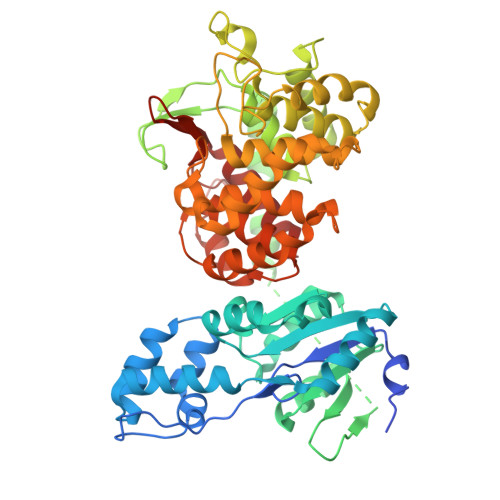Crystal structure and catalytic mechanism of drimenol synthase, an unusual bifunctional terpene cyclase-phosphatase.
Osika, K.R., Gaynes, M.N., Christianson, D.W.(2025) Proc Natl Acad Sci U S A 122: e2506584122-e2506584122
- PubMed: 40569382
- DOI: https://doi.org/10.1073/pnas.2506584122
- Primary Citation of Related Structures:
9MHS, 9MLO - PubMed Abstract:
Drimenol synthase from Aquimarina spongiae (AsDMS) is a highly unusual chimera that integrates two distinct, sequential isoprenoid processing activities within a single polypeptide chain. AsDMS catalyzes the class II cyclization of farnesyl diphosphate (FPP) to form drimenyl diphosphate, which then undergoes enzyme-catalyzed hydrolysis to yield drimenol, a bioactive sesquiterpene alcohol with antifungal and anticancer properties. Here, we report the X-ray crystal structures of AsDMS and its complex with a sesquiterpene thiol. The AsDMS structure exhibits a didomain architecture consisting of a terpene cyclase β domain and a haloacid dehalogenase-like phosphatase domain, with two distinct active sites located on opposite sides of the protein. Mechanistic studies show that dephosphorylation of the drimenyl diphosphate intermediate proceeds through stepwise hydrolysis such that two equivalents of inorganic phosphate rather than inorganic pyrophosphate are coproducts of the reaction sequence. When the AsDMS reaction is performed in H 2 18 O, 18 O is not incorporated into drimenol, indicating that the hydroxyl oxygen of drimenol originates from the prenyl oxygen of FPP rather than a water molecule from bulk solution. These results correct a mechanistic proposal previously advanced by another group. Surprisingly, AsDMS exhibits substrate promiscuity, catalyzing the conversion of the slowly reactive substrate mimic farnesyl- S -thiolodiphosphate into cyclic and linear sesquiterpene products. Structural and mechanistic insights gained from AsDMS illustrate the functional diversity of terpene biosynthetic enzymes and provide a foundation for engineering "designer cyclase" assemblies capable of generating a wide variety of terpenoid products.
- Department of Chemistry, Roy and Diana Vagelos Laboratories, University of Pennsylvania, Philadelphia, PA 19104-6323.
Organizational Affiliation:




















